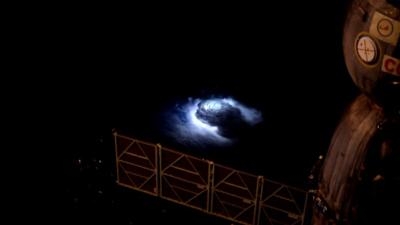ESA Studies Lightning On Earth
Lightning triggers powerful electrical bursts in Earth’s atmosphere almost every second. The inner workings of these magnificent forces of nature are still unknown, but a rare observation by an ESA astronaut gave a boost to the science community. A European detector will take on the challenge of hunting for thunderstorms from space next week.

As he flew over India at on the International Space Station in 2015, astronaut Andreas Mogensen directed a high-resolution camera towards a gigantic thunderstorm. He caught a blue jet repeatedly shooting up into space towards the upper layers of the atmosphere – as high as 25 miles.
The spectacular footage was the first of its kind. His discovery of a pulsating jet gave a new perspective on the electrical activity at the top of tropical thunderstorms. Scientists began to learn what types of cloud trigger such phenomena, and how they may affect the chemistry of the atmosphere.
The solid scientific results gathered a lot of attention and confirmed the Space Station as a great vantage point 400 km above the clouds. Apart from covering all the main thunderstorm regions, it is the space platform that brings instruments closest to the electric events.
A sophisticated monitor designed to look for electrical discharges born in stormy weather conditions will be on its way to the Station next week. The Atmosphere-Space Interactions Monitor, or ASIM, is a collection of optical cameras, light meters and an X- and gamma-ray detector.
It is the first time such a sensitive instrument will fly into space to observe the inner anatomy of lightning. “The science we hope to do by combining data from all the instruments is explosive. Simultaneous observations will bring a whole new insight,” says Torsten Neubert, science team coordinator at the Technical University of Denmark.
The biggest challenge is how to measure the phenomena in their entirety. The timescales are short – a tiny fraction of a second – and the size is big – several miles wide. “Up in the atmosphere, the thin air slows down and enlarges the discharges. That gives our instruments a better chance to observe them in all their glory,” explains Torsten.
Gigantic electrical discharges in Earth’s upper atmosphere are also fascinating displays of the processes taking place inside thunderstorm clouds. Mounted on the outside of Europe’s Columbus laboratory, the observatory will open a new window onto lightning.
Lightning affects the concentration of atmospheric gases that are important for the climate. New data will improve our understanding of the effect of thunderstorms on the atmosphere and contribute to more accurate climate models. The measurements will be coupled with those coming from meteorological satellites and ground observations from all over the world. More than 100 dedicated experts from eight countries have participated in the project so far.
ASIM is already sitting inside the SpaceX Dragon capsule and ready for launch next Monday from Cape Canaveral, FL.
(Image provided with ESA news release)
 Aero-TV: DeltaHawks Diesel Power Steps Into the Spotlight
Aero-TV: DeltaHawks Diesel Power Steps Into the Spotlight NTSB Prelim: Mooney Aircraft Corp. M20K
NTSB Prelim: Mooney Aircraft Corp. M20K ANN FAQ: Turn On Post Notifications
ANN FAQ: Turn On Post Notifications ANN's Daily Aero-Linx (12.20.25)
ANN's Daily Aero-Linx (12.20.25) Aero-News: Quote of the Day (12.20.25)
Aero-News: Quote of the Day (12.20.25)



